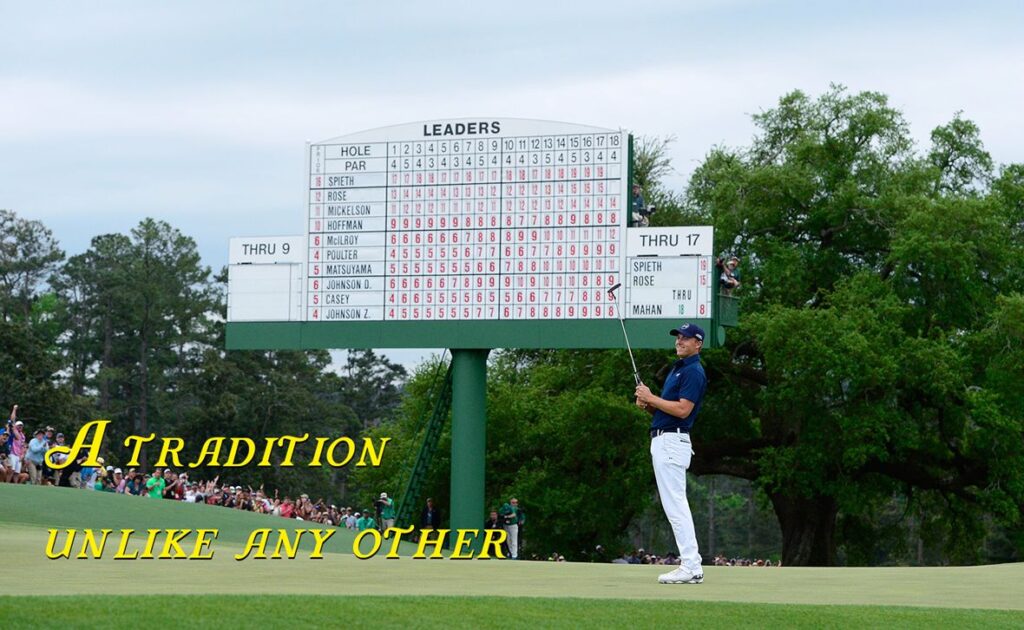The Masters Tournament: Truly Second-To-None
By Mike May
The great thing about The Masters golf tournament is that you really don’t have to like golf or even understand golf in order to really enjoy The Masters. Whether you are watching a broadcast or you are walking along the grounds of this historic piece of eastern Georgia real estate, there’s an element of class and prestige that emanates through your television, laptop, tablet or your smart phone about the atmosphere at the Augusta National Golf Club. That feeling starts as soon as you tune into the broadcast coverage.
There are a number of newsworthy aspects of The Masters, many of which are unknown to some of the tournament’s most loyal patrons. This confirms that The Masters tournament is ‘a cut above the rest’ and ‘a tradition unlike any other.’ And, it’s a position which Augusta National’s membership relishes and cherishes.

Listed below are the key facts about The Masters:
- Dinner Reservations. Winners of The Masters each year are invited that night to join the members of the Augusta National Golf Club for dinner in the Trophy Room inside the clubhouse. The meal starts soon after the awarding of the Green Jacket inside Butler Cabin and on the 18th green, upon the conclusion of the tournament.
- Sleepover Special. Amateurs who play in The Masters each year are invited to stay in the Crow’s Nest, which sits at the tip-top of the Augusta National clubhouse. The Crow’s Nest sleeps five and has 1,200 square feet of living space.
- Trophy Time. The permanent Masters trophy weighs 100 pounds and it features the name of the annual winner of the tournament and the name(s) of the runner-up. The winner of The Masters receives a replica of the real trophy and a gold medal, both of which he is allowed to keep. The replica weighs only 20 pounds. The permanent Masters Trophy, built in England, features 900 separate pieces of silver.
- The Clubhouse. The Augusta National clubhouse predates the building of the golf course as it was originally a private home built in 1854.
- Keeping Up with the Jones’. In the first edition of The Masters (in 1934), then known as the Augusta National Invitation Tournament, Bobby Jones competed in the event, where he finished in a 13th place tie with Denny Shute and Walter Hagen. Jones’ 72-hole score was +6, which was ten shots behind the winner Horton Smith.
- Naming Rights. The credit for the naming of each hole at the Augusta National Golf Club is given to Louis Alphonse Berckman, Bobby Jones, and Clifford Roberts, who adorned each hole with a plant for which it is named. The course starts with Tea Olive (1st hole), though it was originally called Cherokee Rose, and concludes with Holly (18th hole).
- Arnie’s Plaque. On April 4, 1995, a bronze plaque, in honor of Arnold Palmer’s play and contributions as the first four-time winner of The Masters, was unveiled. The plaque is affixed to the water fountain which sits behind the 16th tee.
- Jack’s Plaque. On April 7, 1998, a plaque, in honor of Jack Nicklaus’ play and contributions as the only six-time Masters champion, was unveiled. The plaque is affixed to a drinking fountain that sits between the 16th and 17th holes.
- By Invitation Only. There are 19 different criteria which The Masters Committee uses to draft the list of players who are invited to play in The Masters each year. The Masters Committee, at its discretion, also invites international players not otherwise qualified. Previous winners of The Masters are automatically invited to return every year.
- Who Is Rae? Rae’s Creek, which appears on the 11th, 12th, and 13th holes at Augusta National, is named after John Rae, who died in 1780. Rae’s house was the farthest fortress up the Savannah River from Fort Augusta. His house kept residents safe during Indian attacks when Fort Augusta was out of reach.
- The Green Jacket. The tradition of awarding The Green Jacket to the winner of The Masters started in 1949, when Sam Snead won. The tradition of the members wearing a green coat started in 1937. The jackets were purchased from the Brooks Uniform Company in New York City. Each Green Jacket is adorned with brass buttons. The logo of the Augusta National GC appears on each button. The green jacket’s color is referred to as the masters green, but in reality, the shade of the terrific rye green used is Pantone 342.
- Par 3 Tournament. The Par 3 Contest at The Masters was first held in 1960. It was won by Sam Snead. To date, no player has ever won both the Par 3 Contest and The Masters in the same year. Jimmy Walker, who recorded an eight-under-par round of 19 in 2016, has the course record. Because of COVID-19, the Par 3 Contest will not be held this year.
- Winner Buys — Next Year. On the Tuesday night of Masters week, all previous champions of The Masters gather for the Champions Dinner, which is held in the main clubhouse. The defending champion of The Masters selects the menu and hosts the dinner. The only non-winner to attend the dinner is the current chairman of the Augusta National Golf Club. This tradition started in 1952 with Ben Hogan. The meals have ranged from cheeseburgers, fries and a milkshake by Tiger Woods in 1998 to elk and wild boar by Mike Weir in 2004 to chicken panang curry by Vijah Singh in 2001 to Spanish seafood paella by Phil Mickelson in 2011. “You’re in a room amongst great players,” said three-time Masters champion Gary Player. “The ambiance of the whole place is remarkable. And, you hear so many stories. It’s something special.”
- Dusk-to-Dawn Destination. For years, the premier accommodation option in Augusta has been the Partridge Inn, the grand dame of Augusta’s hotels. The P.I. Bar and Grill, the hotel’s famous restaurant, is the place to be and to be seen during Masters Week.
- The Bridges Over Rae’s Creek. The Augusta National Golf Club has three named bridges – the Hogan, Nelson, and Sarazen bridges. The Hogan bridge crosses over Rae’s Creek, allowing players to reach the 12th green. It was dedicated to two-time Masters champion Ben Hogan. The Nelson bridge crosses over Rae’s Creek, allowing players to reach the 13th green from the 13th fairway. It was dedicated to two-time Masters champion Byron Nelson. Both the Hogan and Nelson bridges were dedicated on the same day — April 2, 1958. The Sarazen bridge crosses over Rae’s Creek, allowing players to reach the 15th green. It was the first named bridge at the course, dedicated to former Masters champion Gene Sarazen on April 6, 1955, as a way to celebrate the 20th anniversary of Sarazen’s famous double-eagle – the famous Shot Heard Round the World — at the 15th hole during the final round of the 1935 Masters, which he won in a playoff against Craig Wood.
- Michelson’s Moment in Time. While on his way to winning his third Masters title in 2010, Phil Mickelson drove the ball through the 13th fairway and into the trees during the fourth round. Most players would have laid up short of Rae’s Creek, but Mickelson took his six iron and struck a perfect shot, from the pine straw, onto the green which he converted into a birdie four. The helped pave the way to his third Green Jacket. A plaque has been made and placed on the spot on the 13th hole where Michelson struck that shot.

Next time you get together with friends to watch The Masters, you should enlighten your colleagues with some interesting facts about this event which is truly second-to-none, ‘a cut above the rest,’ and ‘a tradition unlike any other.’

